If We Can Map The Twists That Play With Copy, Can We Map Copy Natural History Itself?
Mapping the twists that play on Copy is one thing, but mapping the places where these Copies are to be found is quite another. This is because to map Copy natural history we must map the human condition itself.
We know something about the range of twists that exploit the logic of the Original/Copy relationship. Yet it seems we know rather little about the natural history of copy culture. Because so far, we have been relying on the colloquial categories present in our own particular language, and these are unlikely to be definitive.
Categories such as:

Now let us take a closer look at this colloquial classification, by looking at a range of copies in the hope that an underlying pattern might emerge. To be clear, this is not intended to be anything more than just a preliminary ramble and wandering through the natural history of copy using the categories above as pointers along our way. It is not intended to be an objective account of the range of the Original/Copy relationship therefore, but merely to serve as the first small step in that direction. So let us begin our survey with a token set of examples from the world of 2D and 3D ART:


At first sight, it seems that the art world forms quite a distinctive easy-to-identify category of copy. A fact helped by the quite specific range of copy context that art finds itself in. Galleries, museums and the inside walls of our living quarters, where the art is often held in a frame or mounted in a special place, are where we normally find art. But parks, gardens, squares, and even entrances to large buildings, also make a familiar locale for works of art, and for sculpture in particular.
Nor is the context the only distinctive feature of this world of art. So if we look at the human basis for making art in the first place, we find that there is one fundamental aim underlying the work of artist. Because the purpose of the artist is surely to create a visual surface or form that is as compelling as possible. Not necessarily beautiful or true or good, but for a work of art to really succeed and indeed last, it must be compelling in some way, and there are many ways in which a visual display can be compelling. For example, art can inspire religious feelings, amuse or shock us, capture a recognition or spark an unconscious meaning, represent the next step in a movement from the past, open up new ways of seeing the world, act as an investment, and mark a certain level of sophistication or celebrity status. At which point we have to realise that, although the idea that the artist is there to create something compelling makes a good unifying formulation, there is much more to it than that. Because it is the source of this power harnessed by the artist that is critical to the result, and this source can be as varied as fame, novelty, money, belief, and precedent, to name just a few.
Another problem arises when we attempt to draw line between the categories of art and decoration. For example, the photo of the scorpion chair offers us an object that is both visually compelling and yet utilitarian, making it a piece of craftsmanship that aspires to a higher expressive goal, even though it is primarily a chair, and will always invite us to take a seat in it (though mind your head against the sting). So it is easy imagine this chair as a piece of art in a gallery, though it would not look out of place in an up-market furniture shop either.

Nevertheless, the idea that the world of Art is a useful category seems to be a good one, particularly when compared to the next category. Because in this next case, where we look at some more copies, the category looks somewhat miscellaneous and even artificial. So now we look at the military world of BATTLE:
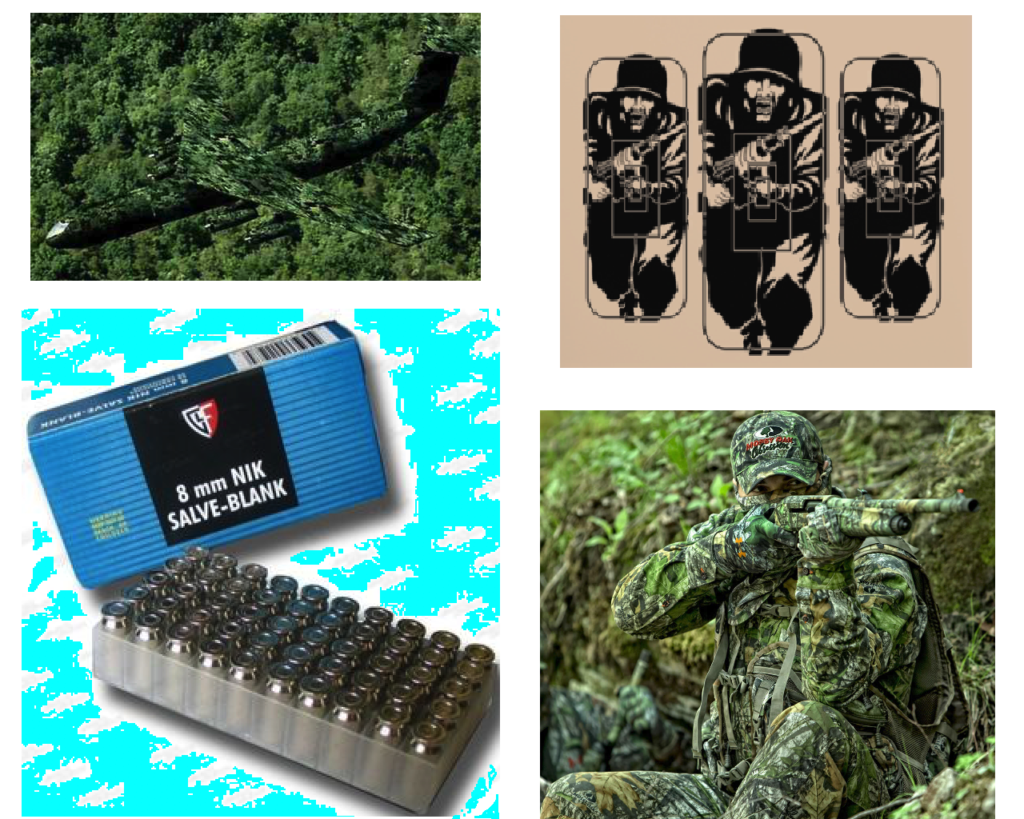
Right away, we see that camouflage, blank cartridges, and targets from the shooting range are rather different forms of copy. They are all copies of course, but they do rather different things, albeit all in the service of warfare. The camouflage imitates the background vegetation in order to save the soldier or the vehicle with soldiers inside. The target, which might also be said to save us a soldier or two, replaces the soldier with an image that can be shot at without damage to the intended real target of a real man. Whilst the blanks ensure that no stray bullets are flying around during manoeuvres and close quarter practice sessions. So in that sense, all three copies serve the common purpose of saving lives on the home side, whilst at the same time making it easier to take them on the enemy side. Yet despite this unity of military purpose, the copies do seem qualitatively different in some way. Perhaps this is because the purpose of the target is that it be fired at, whilst the purpose of camouflage is that it divert fire away from it. And the blanks are made in order to render any firing harmless to begin with. But as all three are to do with the act of firing or being fired at, all three do come together quite nicely under the category of military copies.
For our next colloquial category, we look at some of the many examples from the copy rich domain of the human BODY:


The copy context of this category is the human body, which is well defined, and apparently without need of qualification. However, there is variation within this category of bodily parts. Some of the copies are about enhanced appearances (wigs, false eyelashes and nail extensions), whilst others serve as medical and practical necessities (prosthetic limbs and false teeth). Yet others satisfy particular sexual needs, while the tailors dummy supplies the very particular function of providing a substitute torso for dressmaking. Which means that if we were to adopt a functional approach to copies, where for example body enhancement was separated from straightforward part replacement, then this category of ‘Body Copy’ would be blown in two, with the other practices also separating out into their rather specific applications, and under quite different categories of meaning.
In the next category, there is no specific physical context to unify the variation of copies that exist within it because it is all about a practice rather than a place. The practice in this case is the world of BUSINESS, mainly comprising publicity models, and a whole range of sellable products ranging from reproduction furniture, paintings, and kit cars to replica weapons and watches:
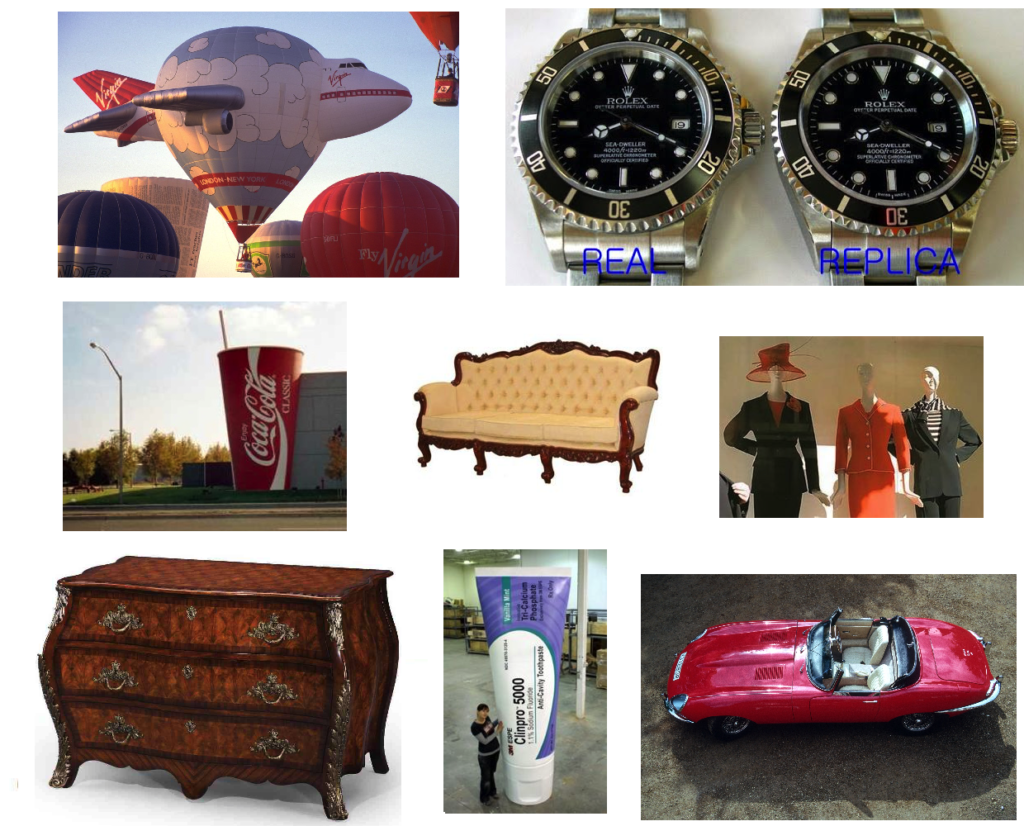
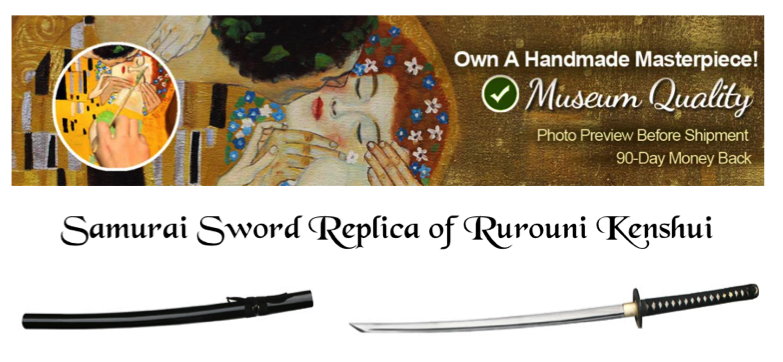
In the case of the publicity copies, greater size is often the main feature, because that is how peoples attention can be gained. A larger than life product not only looks more impressive, but it is also far more visible. But publicity copies seem qualitatively different to replicas and reproductions designed to sell to the public. And within the class that includes reproduction furniture and paintings, it is clear that the motives for buying such copies may differ. Reproduction furniture can be about nostalgia, style and love of the past, but sometimes people buy a good reproduction of their original Matisse so that the latter can stay locked away in safety, whilst the copy sits above the mantlepiece (and nobody guesses that it is not the real one). And clearly the step from an authentic quality copy of a valuable painting to a deliberate fake that can be sold for a fortune is not a large one, such is the continuity of meaning between the one form of duplicity and the next. Meanwhile, the shop window dummies (or mannequins) serve a very similar purpose to the tailors dummy in the previous category, with both acting as copy bodies that allow us to check out how an item of clothing looks, though in the case of the shop window mannequin, this inspection is somewhat superficial when compared to the care taken by a dressmaker.
Another example of the continuity between categories is the similarity that exists between the world of Art, and the world of Decoration. Because both are visual, and both come to us in two or three dimensional forms, and it is often only a matter of taste that distinguishes the two. So, the world of DECORATION is full of copies of all kinds, though it should be added that many forms of decoration are abstract, and do not make any reference to the world of things, so it only with the copy side of decoration that we are concerned here:

Decoration can be very well done, as we see here in the example of the presumably hand wrought golden leaves on the door of a wall at Hampton Court Palace near London. On the other hand, it can be done in a simplistic way, and mass produced, as in the case of the green frog (which features elsewhere in this website as it is, to all my past students, the focal point of the famous ‘green frog test’). So what characterises the copy as a form of decoration? The fact that it has no pretensions to being a work of art? The fact that is often integrated into something that serves a serious practical purpose (such as the fake books in the hidden door)? The fact that it is often mass made and cheap? Or perhaps the fact that it panders to the lowest common denominator in public taste? Then there is the context. Decorations occur on the ceiling or wall inside a house, or on a public building, and may be found on surfaces such as the mantlepiece too. In the past, old tools, weapons and vehicles often carried decoration in the form of animal heads, or plants and so on, as do some more modern pieces of furniture, and even some cars (think of the Jaguar for example). So, all in all, there seem to be a good number of different kinds of decorative copy, some being quite subsidiary to their context, and others having almost stand alone status; some showing no express use other than their role as a unit of decoration, and others combining their expressive role with a practical function that is the primary reason for the existence of the object in the first place.
The fundamental duplicity of the copy makes it a major source for the next domain of FAKES and FORGERIES:

As we have already seen, there is little distance between the duplicate painting or for example, duplicate diamond necklace, and the fake equivalent of the same. Because the job of both is to look as authentic as possible, and once it looks the same, it can be used to make the claim that it is the real thing, with commensurate gains on the part of the claimant. But for somebody to go to the pains of making a fake, it must focus on an object that has as much worth as possible, though that worth is not always about money, as various fakes in the past in the academic and scientific world bear witness to.
Then there are the three and two dimensional copies that abound in GEOGRAPHY:



Such copies may be two or three dimensional, and may map much more than just the physical landscape around us. Even so, they form a well defined group of copies, being graphic or concrete representations of areas of some kind of physical space. So there are some anatomical maps, and maps of the tube in London that make little of the actual location of things in favour of a clear presentation of the relative position of important features such as organs or stations. Whilst other maps illustrate circuitry or molecular structure, serving as models for both teaching and technology. But because they describe the physical positions of their physical components, to a greater or lesser degree of course, they belong to the category of maps and charts. And given that the physical and biological sciences have made a large part of their progress through elucidating and recording the physical structure of the phenomena around us, it is clear that this form of copy is very important indeed.
Another category that has a much more specific physical context is the class of two and three dimensional copies representing real life, fictional, legendary and mythical figures. Namely, ICONIC FIGURES. Below we find Prince Albert, Churchill, the Ukrainian statue of Nationalism, the statue of Liberty, Ghandi, the Rio Redeemer, the golden Buddha, Queen Victoria, Another Buddha and Stalin.
![]()
Most iconic copies belong on a pedestal, not on a podium. After all, either they have long since died, or they have never existed as real mortals in the first place. Generally they are religious, political or military in origin. There are relatively few statues of scientists, artists and the like. Which when one considers the relatively colossal impact of say Newton or Darwin on this world, must tell us a lot about the human race that we would rather not know. However, the category of commemorative and celebratory copy is quite a clear one, at least until the point where we have to consider what values the individual icon represents. A point that then rapidly becomes a widely diverging area of ideas according to whether the figure is religious (and which religion), political (and which country and period) or military (which battle). So perhaps we should not be tempted by the apparent definability of this group of copies after all…
Some copies are made to fool, not so much us, as the animals around us. But note that we also can become the victims of such copies. For this is the world of LURES, DECOYS and SCARES, and some of the photos below need some explaining. In particular the shot of the two deer, one mounting a decoy that has been specially treated with the correct pheromones to attract the target male for hunting. The next shot of a decoy deer is (almost unbelievably) designed to lure and catch the illegal out-of-season hunter. And although we are familiar with the use of a scarecrow in the fields to deter the birds, it turns out that it is also possible to scare motorists from speeding through a village using the same technique, which is what we see in the last frame.


The decoys, lures and scares that we find here, are about our relationship with the animal kingdom, apart from the two, reasonably eccentric, examples that feature humans as their target. So we use these copies to lure animals into the range of our guns or fish hooks, and to frighten them away from our crops. Of course the natural world is a great user of copy, as we see in the common use of camouflage and lures and mimicry, but natural copies are outside the realm of meaning, being entirely explicable in terms of the bio-logic of life, and so must never be confused with the Original/Copy relationship.
Another line of copy is based on the idea that by doing something to the copy, one is also doing something to its original, based on some hidden but presumably powerful link between the two. This being the category of copy MAGIC
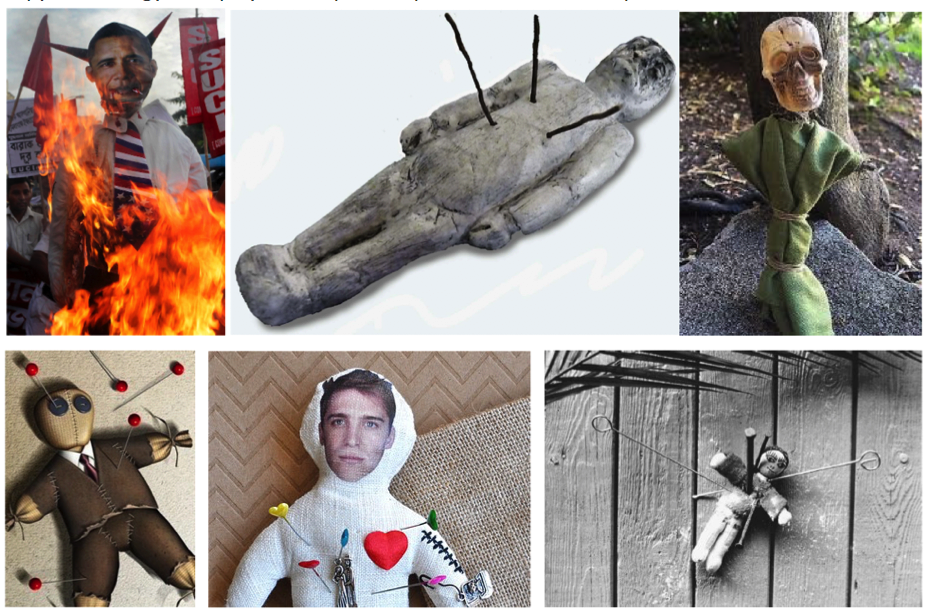
Around the world, there are many people fascinated by the possibility of a magic and causal link between the copy of somebody, and that person. A British friend of mine in Bolivia once showed me an effigy with his passport photo attached to the head that he had just found secreted under his bed, put there apparently by his errant indigene wife. There were pins stuck through the limbs in what was clearly an attempt to cause her husband some serious pain. But this is a practice that occurs all around the world, and this is because the link between the original and its copy is just too good to pass up on where the practice of magic is concerned. Interestingly, it seems that the close link between an original and its image (whether shadow or reflection) that we cover next is not open to such manipulation. This is because the image is beyond our physical control (try sticking pins in a shadow), and is never separate from its original. So instead the solution must be to suggest that people of power (evil or otherwise) do not cast a shadow or show a reflection in a mirror, and that is exactly what we find in stories about Count Dracula for example.
Copy technology also plays an important part in our efforts to pursue SCIENCE and TECHNOLOGY:


Copies in the form of models can be used as valuable teaching tools. But they can also be important in working out how the unseen is configured in the first place. Just as Watson and Crick used metal clamps and other pieces to try out different options in the elucidation of the structure of DNA. In experiments too, models can be used to assess how things are likely to behave without jeopardising the real thing, which may in any case be tricky to test due to practical problems such as size and accessibility. So a flight simulator saves using a precious plane, and car crash dummies save using real bodies. Fabrication of objects can also depend on the use of moulds, which are often inverse copies of the original (though 3D printing may reduce this particular practice). A practice which poses an interesting question: surely the use of a mould is a physical activity so far removed from meaning that it is not a good focus of our attention here? What we do with our moulds is clearly important, but the way we exploit copy duplicity to engineer these results is another matter, and one that is purely physical artifice. So should we ignore such activity, even though we have to pay lip service to these forms of copy as part of the general picture of copy use in human affairs? Well, as always, it is the purpose that lies behind the creation of each copy that gives it the meaning we must focus on. So the various ways in which copies or indeed the products of moulds are fabricated is peripheral to that focus, and should not be part of this general survey.
The next domain normally relies on just two dimensions for its expression – the world of SYMBOLS and SIGNS:


Signs and symbols use graphic representations of the physical world around us, but in a simplified style that, along with their utilitarian status, marks them apart from two dimensional art. Signs communicate information, often writ large for visibility, whilst symbols act as markers for social groups, features on maps, the elements of the periodic table, and a wide variety of other human concerns. However, it is only when the two forms are clearly derived from a physical original that they are to be considered forms of copy.
The world of stage and entertainment is copy rich because it includes many props, puppets and costumes – THEATRE

Stage sets and films sets are full of copies, because it is not always useful or convenient to set the actors in a real setting. The freedoms that accrue from staging the play or film inside the physically controlled context of a set are important ones. Important to the extent that the whole set can be totally destroyed, created according to wild fancies that are not found in real life, created to represent the distant past, or created to replace places that are just too remote or costly to use in the present. Nor does this just apply to buildings and general settings: because there are many kinds of theatrical costume, puppets, and fake items that make the show that much easier to stage. One of these is the classic stage knife with the retractable blade that goes back into the handle when pressed against the victim, so that no actual damage is done. And in the Spitting Image shot of the queen and prince Philip above, we find that the copy makes an excellent vehicle for exaggeration and caricature as long as the likeness is strong enough for the humour to be recognisable as being about a particular person.
Finally, we have the whole vast domain of TOYS and GAMES:
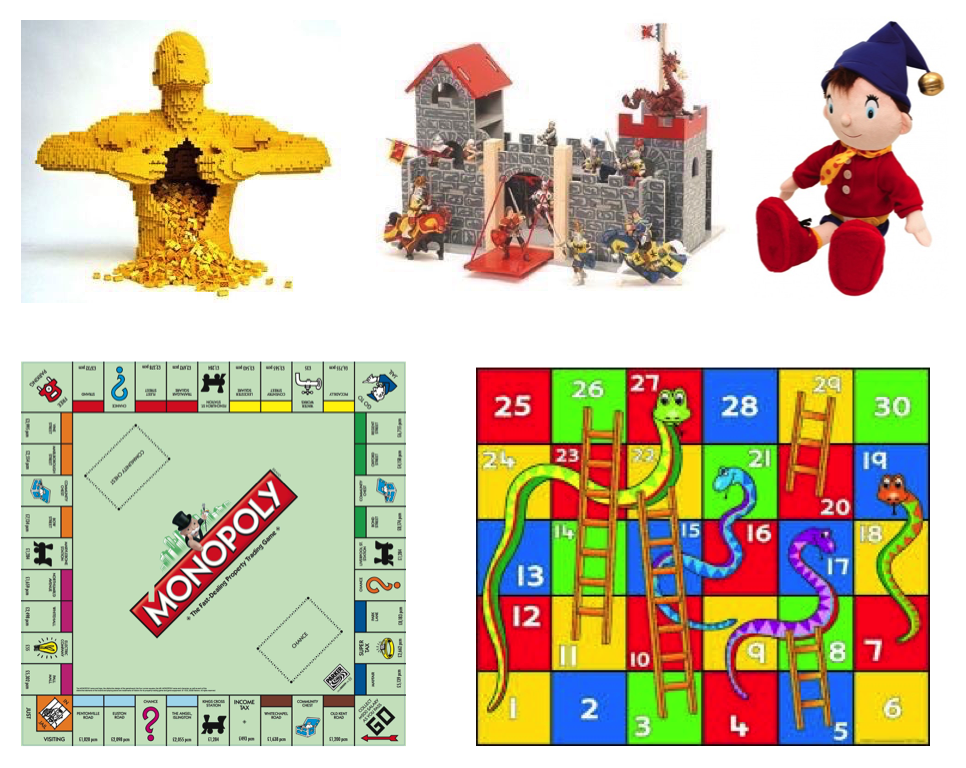

Well, this is only a small sample of the copy natural history available in our copy rich culture, but it does show the range of variation quite well, and for that, we must thank the everyday colloquial categories that we use in our language and social organisation. In fact, once we do see the whole range of copies collected in one place like this, we begin to appreciate their great importance and ubiquity in our own culture. But what also becomes clear is that the mapping of such a wealth of form and function is going to be quite a challenge. Not least because the richness of human purpose that created all of this in the first place is so very wide, deep and particular in its level of detail. So now let us look at an alternative set of categories that may assist with the mapping out of copy variation.
The Oxford-Duden Pictorial French and English Dictionary displays about 30,000 different objects and parts of objects ranging right across the whole spectrum of physical things that are known to man. This is achieved in about 650 pages of drawings and listings, with many of the drawings showing a particular context, such as primary school, countryside in winter, carpenters workshop, the kitchen, operating theatre and so on. Other drawings show the range of an object such as headgear, jewellery, musical notation, colours and different sailing boats. So basically, this is a book absolutely packed with illustrations. The broad organising categories of which are:
Atom, Universe, Earth
Man and his Social Environment
Nature as Environment, Agriculture and Forestry
Trades, Crafts and Industry
Printing Industry
Transport, Communications and Information Technology
Office, Bank, Stock Exchange
Community
Recreation, Games, Sport
Entertainment, Culture and Art
Animals and Plants
This set of categories clearly represents a serious attempt to classify the world of things in a way that makes it easy for us readers to find what we are looking for as quickly and as easily as possible. An aim which suggests that the classification is based on a real knowledge of how we understand the place of things here in the West. But then we look more closely at this listing above, and find some surprising elements to its organisation. For example, why on earth do we have a whole category just about the ‘Printing Industry’? Could this be a reflection of the publishers own focus perhaps? Because it is hard to imagine that kerbstone opinion would rate the printing industry as a major category of things physical…
Then we find, on closer inspection, that Mathematics comes under Entertainment, and Hunting comes under Agriculture, which some of us might have issues with. But none of this should really surprise us, because we know very well that any classification of meaning is going to be controversial, and in any case, home grown versions like this one are not pretending to be definitive, but simply useful.
But the important thing about this dictionary, at least for our purpose, is that it represents a large collection of pictures of physical phenomena and objects. So the categories that serve to classify these objects might possibly assist us in the challenge of classifying copy natural history. But then when we try them out on our sample picture gallery above, we seem no further forward. So maybe we should try a different approach, where we cross reference this first set of categories with the logic underlying their copy use. As we see below (note some alterations have been made to the primary listing to make this work better).


Again, although we are improving our listing of things to do with copy, we are no nearer to an understanding of how the different areas of copy belong together. So maybe we should just free copy advantage from all these particular categories of life, such as Art and Theatre and Toys, and look for the common points that apply, whether to one category or the many? Such as in this listing below, where the copy advantage is not tied to any particular area in the copy topography.
To deceive, like fake money or decoys, bait, false nails, camouflage, and stage set
To decorate, like acanthus leaves, trompe d’oeil, and ducks on the wall
To interpret and externalise, like paintings, statues, and architects models
To play with, as in the whole world of toys and games
To render safe and easy to handle, like blank shots, stage set knives, toys…
To dramatise, as in publicity models and art
To teach with, as in the model of our solar system, or DNA, or in flight simulator
To investigate, as with crash test dummies and prototypes
To have a duplicate, as with the mold of a dinosaur fossil, or a scarecrow, or a window mannequin
To avoid damage, as with a human target, fake bear, or dodgem car
To amuse, as with puppets, fancy dress masks and costumes, and simulator games
To avoid organic limitations, such as plastic flowers, or hair falling out
To find our way, as with maps and road plans
To plan ahead with, as in the use of a mock up prior to a battle, or an architects model.
To deify, as in statues of heroes and religious figures
Well, the one thing this list does do is make us face the multiple identity of many of the copies that we have been looking at. For example, a toy has a number of copy advantages: it is safe, it is cheap, it is available, it is easily changed to make it cuter or more colourful, it is educational, it is smaller, and it is easy to handle. So trying to define its position in our culture through its particular copy advantage is not going to help very much. Or take a metal globe of our planet – does it belong with the study of Geography, or is it a tool for Teaching, or does it belong in the Science category? Whilst a false set of eyelashes must surely fit both the categories of Body and Decoration, and might not this set of eyelashes be considered as a lure and a fake as well?
Indeed, there are many examples which fit more than one of these categories, which means that really these groupings are just a holding bay whilst we look for some more insight into their real nature. Which does not mean that some of the categories are not useful. It’s just that although some of them may turn out to be relatively objective, some will have to be discarded. And once we have devised a set of categories that resolve the problem of ambiguity and multiple membership, we must set up an overall picture of human purpose within which these groupings have their place and connections.
It is at this level of defining the categories of copy that we finally see the true scale of the problem represented by copy natural history. After all, it is one thing to map out the copies, and the twists and even the legits that play around with these twists within the compass of humour, but quite another to create a map of the whole relationship. And when we talk about where the Copy belongs in the greater scheme of things, we really do mean the whole picture – the whole human condition. Meaning that categories like Toys and Art must immediately lead us into a consideration of major dimensions of human value and purpose. Or to put it another way, if we can map copy variety properly, then we have probably also created a real and substantial science of meaning, on a level with the physical and biological sciences. A point that is as considerable, and as daunting, as it is extreme.
Well, we come back to this overall challenge later in the website, when we consider what a DNA of meaning might be. But for the moment, this section has served the dual purpose of dramatising both the challenge of copy variety, and the question it leads to, so this makes a good place to move on to another relationship played with by humour. The Original/Image relationship, to be precise.
